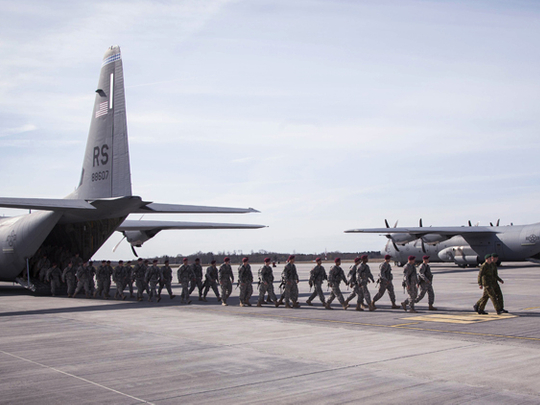
For years, leaders of this Baltic state were an irritant at Nato meetings, insisting to eye-rolling ambassadors from Western Europe that Vladimir Putin’s Russia was a revanchist power bent on destabilising and dominating its neighbours. Now they voice grim satisfaction that what was once dismissed as paranoia has become the West’s conventional wisdom. But the satisfaction has its limits. “The thing about being a Cassandra, being right is not necessarily great,” President Toomas Ilves told a security conference last week. “Because if you have read your Illiad, you know she dies.”
Estonia and the two other Baltic republics swallowed by the Soviet Union in 1940 are a good place to see how the Ukraine crisis is transforming what for two decades has been the “post-Cold War order” in Europe. Suddenly, the Baltic countries are not tiny backwaters, but “frontline states” on a continent once again dominated by a standoff between Moscow and the democratic West.
A company of US 173rd Airborne Brigade soldiers were flying into Tallinn last Monday as part of a deployment of 600 US troops in Poland and the Baltic states. F-16s from Denmark were due on Sunday at an airfield newly designated as a Nato facility. In Brussels, Nato is debating whether to make the deployment of troops and planes to the region permanent, thereby scrapping a 1997 pledge to Russia not to station forces in the central and Eastern European countries that joined the alliance after the Soviet Union’s collapse.
A threat that once was dismissed as imaginary now looks all too real here. Like Ukraine, Estonia and Latvia have large Russian-speaking populations, concentrated in areas close to the Russian border. Both countries have been accused by Moscow of mistreating this minority. In 2007, Estonia’s removal of a Soviet monument led first to rioting by Russian speakers and then to what appeared to be a massive, Moscow-sponsored cyberattack.
In theory, the Baltics should be invulnerable to the unconventional, quasi-covert war Russia has launched against Ukraine because they are members of Nato. However, pessimists worry that alliance membership may also make the Baltics a tempting target for Putin, should he succeed in dismantling Ukraine. Were the “little green men” of Russian special forces to appear, say, in Narva — a town close to the border where less than half of the population of 65,000 holds Estonian citizenship — may Nato struggle, as it does now, to agree on a response? “Nato cannot afford the Crimea or east Ukraine scenario in any town or any border of any member state,” Estonian Prime Minister Taavi Roivas told me. “That would be the end of Nato.” It is probable that Putin has had the same thought.
How to stop this very 21st-Century model of aggression, with its mix of propaganda, cyberattacks, special forces and troops massed on the border? The Estonians say they have learned some lessons from Ukraine and from their own history. The first is: Don’t hesitate to fight back. “If the first green man appears in Narva, the government knows exactly how to respond,” Major General Riho Terras told the Lennart Meri security conference. “You have to shoot the first green man and the second will not come.”
Actually it is not that simple, as Terras himself quickly acknowledged. There is the problem of fending off the cyberattacks that may accompany disturbances in a Russian-populated area, as well as the concentrated propaganda on Russian television channels. Estonia has made itself Nato’s cyberdefence maven since 2007, but neither it nor Latvia has a local, Russian-language TV channel, even though a quarter of the population in Estonia and a third in Latvia are Russian-speaking.
Then there is the threat of troops on the border. In 2009, and again last year, Russia staged major exercises simulating an invasion of the Baltic states by more than 20,000 troops. That is more than the combined armies of the three countries, which also possess no tanks or fighter planes. Said Terras: “I am absolutely sure that we need heavy armour capability. Russia understands heavy metal and power. Power is not cyber. Power is tanks.”
The chances that Estonia will get that deterrent, either on its own or by a Nato deployment, do not look particularly good. In Brussels, Germany, France and Italy are among the governments lined up against a permanent Nato deployment in the Baltics; a frustrated Eastern European ambassador dubbed them the “white-flag coalition”. The Obama administration deployed the paratroopers as a non-Nato operation and said they would stay through 2014. But US Ambassador to Nato, Douglas Lute, said it was “too soon to tell” whether a longer-term deployment would be needed.
As usual, the Estonians find themselves well ahead of their allies. “The events in Ukraine were a powerful wake-up call for part of the international community,” said Defence Minister Sven Mikser. “But the Baltic countries didn’t need any waking up.”
— Washington Post









